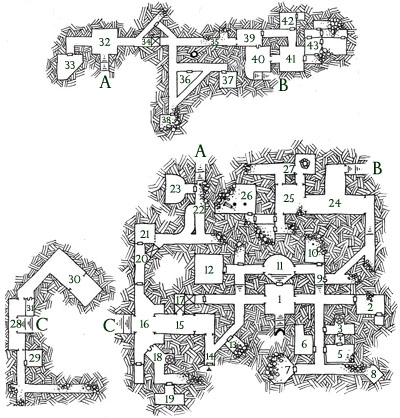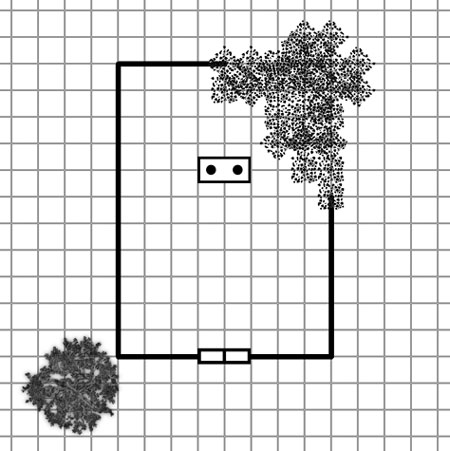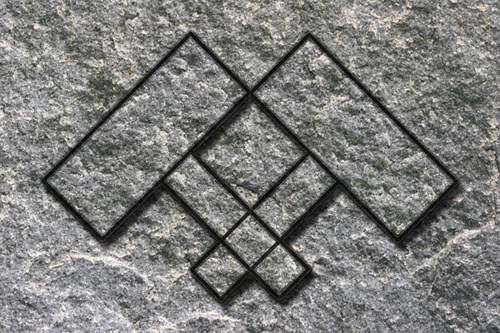(Click for larger map. Original cartography by Dyson Logos.)
Stairs go down about 30 feet.
AREA 1: Thirty foot square. Door in the opposite wall is made of iron. To the left and right are two archways. The archways are formed by two female figures reaching up to touch the hands of the other. The women depicted are slightly different from each other: The ones on the right have shorter hair and are wearing chain shirts with swords strapped to their hips. To the left they have flowing robes with long hair cascading down around their shoulders and wear circlets (with places for gems which have been pried out).
Destroyed Murals: The walls and ceiling here were once covered in brightly painted murals; but the paint has faded and chipped to the point where no recognizable features can be made out.
AREA 2: In the far back corner on the right there is a wooden door. On the left, about midway down the wall, you see what appears to have once been a fireplace. The fireplace is now packed tight with dirt, with a cascade of looser earth spilling out across the floor of the chamber.
Closet: Door to the closet has swelled into the frame and is stuck tight. There’s an empty wooden shelf (swollen and warped). The floor has collected detritus.
AREA 3: This area is a long, narrow hall with an alcove in one wall facing a door. The alcove contains a headless statue of what appears to be a broad-shouldered man wearing a bearskin (the head of the bear hangs down the back). It holds a hammer in each hand. The head of the statue is missing.
Doors: The door from the hall has been smashed in (the lock hangs loosely from splintered wood). If the door leading to area 4 is opened, the hammers on the statues will glow a bright blue and then, a minute later, a strange, high-pitched howl will be emitted by the statue. Both the howling and glow will fade away without any seeming effect a few moments later.
AREA 4: A short hall with iron doors at either end.
Doors: The door to area 3 will trigger a magical effect (see that area). The door to area 5 has been spiked shut from that side.
AREA 5: Three skeletons are laid out on the floor near a collapsed wall. Scraps of leather cling to them.
Doors: The door to area 4 is spiked shut (from this side). The door to the hallway was once spiked shut, but the spikes have been removed (leaving only the holes behind).
AREA 6: A small chamber, twenty foot square. Off to the right there are the shattered remnants of a thin wooden door which seems to have once led to a small closet. There are three broken swords lying on the floor. On the wall opposite the door there are three large indentations, as if someone had taken a great hammer and smashed it into the stone wall.
Broken Swords: Each has caked, blackened blood along one edge of it. The break on each sword looks as if the metal was actually cut.
Indentations: All at the same level. Equidistant along the wall.
AREA 7: The chamber ends in a collapse of rubbled stone.
AREA 8: Reaching this area requires squeezing past the collapsed portion of the hallway. Halflings can squeeze through without problems; others will need to spend some time excavating and probably remove their armor.
AREA 9: Secret door is hidden from this side, but easily detected from the other. It slides to one side, recessing into the wall.
AREA 10: Most of the room beyond has collapsed, sending a cascade of earth against the door (jamming it shut). Due to a confluence of sound, every time someone tries to bash open this door it will echo loudly throughout the complex.
AREA 11: The floor of this chamber curves down to form a pool (now dry and filled with drifts of dust and dirt). The ceiling also curves up. Stairs to the south lead up to the lip of the pool. Archways to the west and east also look out onto the pool. The only way to cross between the archways or the stairs is to climb down into the pool and then climb back up again.
Archways: Formed by two male figures reaching over and touching hands palm-to-palm. The ones to the east are in chain armor; the ones to the west are wearing tunics.
Coins: There are 8 cp mixed into the detritus at the bottom of the pool.
Destroyed Murals: The walls and ceiling surrounding the pool were once covered in murals, but the paint has faded and chipped to the point where they can no longer be identified.
AREA 12: This chamber is empty, but the murals on the wall here are not as badly damaged as those found elsewhere in the complex. On the wall opposite the door, there is a large figure. His face is missing – it appears to have been deliberately defaced; the wall itself has been deeply scratched. The figure wears a bearskin cloak and holds a hammer in each outstretched hand with the heads of the hammers pointed towards each other. Surrounding him are twelve women kneeling and offering various gifts unto him: Amphora in the hands of one; a large golden sword in the hands of another… The others are too difficult to make out; the paint has been too badly damaged.














